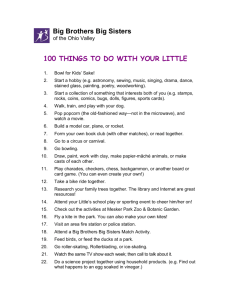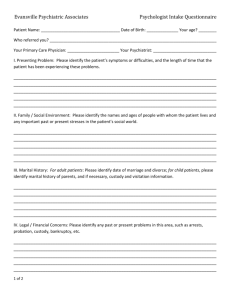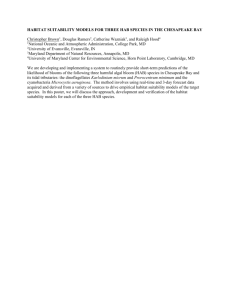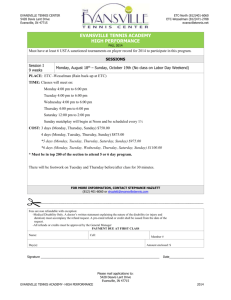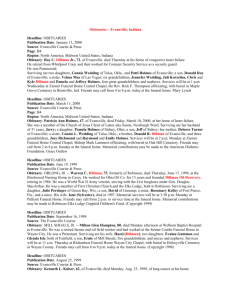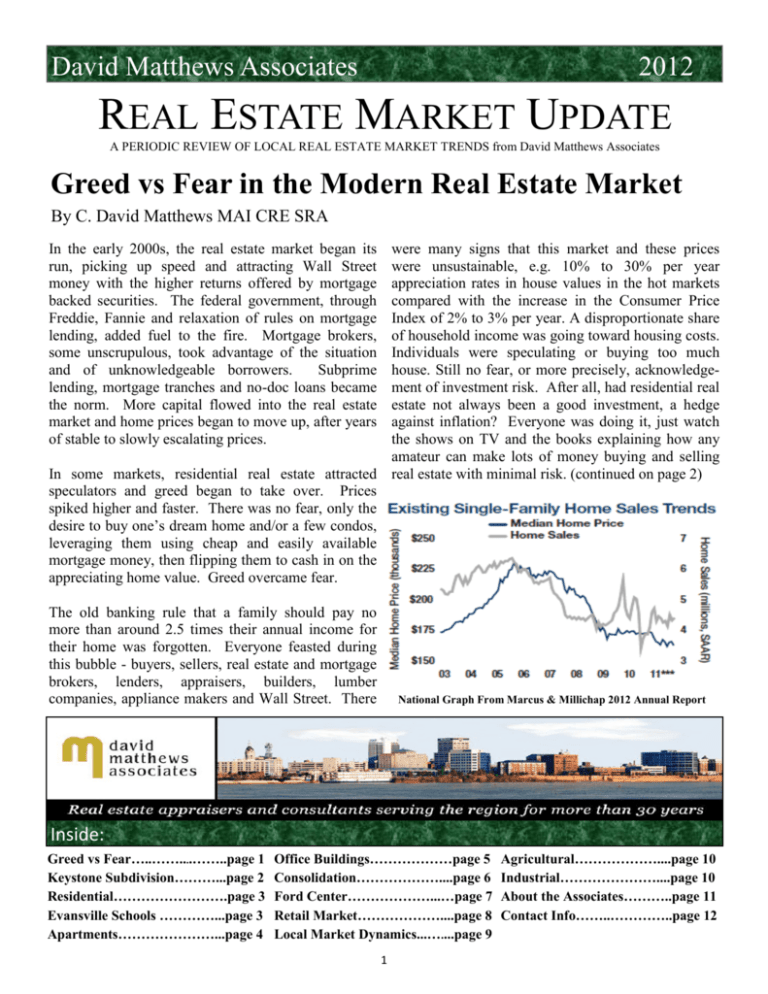
David Matthews Associates
2012
REAL ESTATE MARKET UPDATE
A PERIODIC REVIEW OF LOCAL REAL ESTATE MARKET TRENDS from David Matthews Associates
Greed vs Fear in the Modern Real Estate Market
By C. David Matthews MAI CRE SRA
In the early 2000s, the real estate market began its
run, picking up speed and attracting Wall Street
money with the higher returns offered by mortgage
backed securities. The federal government, through
Freddie, Fannie and relaxation of rules on mortgage
lending, added fuel to the fire. Mortgage brokers,
some unscrupulous, took advantage of the situation
and of unknowledgeable borrowers.
Subprime
lending, mortgage tranches and no-doc loans became
the norm. More capital flowed into the real estate
market and home prices began to move up, after years
of stable to slowly escalating prices.
were many signs that this market and these prices
were unsustainable, e.g. 10% to 30% per year
appreciation rates in house values in the hot markets
compared with the increase in the Consumer Price
Index of 2% to 3% per year. A disproportionate share
of household income was going toward housing costs.
Individuals were speculating or buying too much
house. Still no fear, or more precisely, acknowledgement of investment risk. After all, had residential real
estate not always been a good investment, a hedge
against inflation? Everyone was doing it, just watch
the shows on TV and the books explaining how any
amateur can make lots of money buying and selling
In some markets, residential real estate attracted real estate with minimal risk. (continued on page 2)
speculators and greed began to take over. Prices
spiked higher and faster. There was no fear, only the
desire to buy one’s dream home and/or a few condos,
leveraging them using cheap and easily available
mortgage money, then flipping them to cash in on the
appreciating home value. Greed overcame fear.
The old banking rule that a family should pay no
more than around 2.5 times their annual income for
their home was forgotten. Everyone feasted during
this bubble - buyers, sellers, real estate and mortgage
brokers, lenders, appraisers, builders, lumber
companies, appliance makers and Wall Street. There
National Graph From Marcus & Millichap 2012 Annual Report
Inside:
Greed vs Fear…..……....……..page 1
Keystone Subdivision………...page 2
Residential…………………….page 3
Evansville Schools …………...page 3
Apartments…………………...page 4
Office Buildings………………page 5
Consolidation………………....page 6
Ford Center………………...…page 7
Retail Market………………....page 8
Local Market Dynamics...…....page 9
1
Agricultural………………....page 10
Industrial…………………....page 10
About the Associates………..page 11
Contact Info……..…………..page 12
Greed vs Fear in the Modern Real Estate Market
continued from page 1, By C. David Matthews MAI CRE SRA
All bubbles eventually burst and so
this one did too. Most markets
have, by now, hit bottom though
some are still leaking value, e.g.
the “sandy markets” (FL, CA and
AZ). Too much supply was added
in the condo and residential
subdivision segments. The bloated
prices brought on by the Ponzi-like
scheme housing market began their
fall. The once hot markets saw
home prices fall by 50% or more.
Fear enters the market. Buyers
don’t want to buy in a falling
market and lenders stop lending.
The government overreacts by
applying broad brush rules to
lenders that restrict mortgage loans
appropriately in overbuilt and
overpriced
markets
but
inappropriately in communities
that did not overbuild and overinflate such as Evansville. Now,
everyone is afraid. Fear has a grip
on the market and the lenders,
buyers and investors. Everyone is
waiting to see what happens next.
5% is considered good. So what is
stopping a stronger recovery? It is
fear. Fear of the unknown. Fear
that the Federal government might
do something that increases risk
At this point in time, many of the and reduces return. Fear of losing a
problems with the economy are job or home prices falling again or
psychological. There are plenty of new mortgage default.
bad loans that the banks and the
government must contend with. Evansville has seen the worst and
One study indicated some states, now with rising employment, a
due to their arcane bank regulatory recovering housing market, I-69,
laws, will take decades to work out the Ford Center, and more, our
the bad loans. Typically the US community is poised to emerge
economy won’t rebound without a from the doldrums. We have a
housing recovery. So, what is good supply of vacant residential
and commercial lots. Southwest
stopping it?
Indiana is beginning to see some
There is plenty of pent up demand; new home construction mainly in
interest rates are at historic lows; Northeast Vanderburgh County
home prices are low; the Dow near the new North High School.
Jones fluctuates above 12,000, So, the next 12 months will tell the
companies have lots of capital; and story and I expect it will be
unemployment is under 9% when positive.
Keystone Subdivision By C. David Matthews MAI CRE SRA
The Keystone Subdivision is used as a market barometer since it is a newer, homogenous and popular subdivision located on Evansville’s growing Northside.
These graphs show the peak (2007) and valley (2010) creating a general representation of the overall local
housing market. The price per sq ft was increasing at 1% to 2% per year (near the CPI change) up to 2007.
From 2008 to 2010 the average price per sq ft fell approximately 22% and rebounded over 10% in 2011. An
upward trend is continuing in 2012 up another 9% for the first four months of 2012 though the rate of sales is
down from past years. Prices per sq ft are nearing their 2003 level just before the bubble.
2
Residential Market Overview
By Janice Evans SRA
As can be seen on the accompanying graph, the single family housing market for Vanderburgh, Warrick and
Posey Counties is beginning to recover from the recession in the real estate market. The dramatic drop in
home sales has stopped. The federal government’s actions artificially enhanced sales in 2009 which slowed the
fall to a 2% drop from the prior year sales numbers, but that was followed the next year by another large drop
of 6%. The change from 2010 to 2011 showed the first increase in sales in the last six years. Thru June 15,
2012 1236 homes sold which extrapolates to 2700 for the year for another small increase. So, it appears we
have begun recovery.
We have already seen a softening in prices over
the past few years and it now appears from the
data that prices may well be on the upswing.
The average price and median price for all
three counties studied fell to their lows in 2009
and after that bottom have increased to date.
One market fundamental that created this trend
was a rebalancing in supply and demand. The
number of homes on the market for sale in
relation to the number of homes being sold was
more unbalanced during the decline than today.
The greater Evansville area has survived the worst
downturn in the real estate market since the Great
Depression and has come out of it fairly unscathed.
We are much better off than many other parts of the
country which overbuilt and overpriced due to
speculation. Home prices in Evansville did not
ramp up quickly during the boom but increased at
or near the increase in the CPI. We did not have far
to fall when the recession hit. A conservative
approach in valuing property during the boom has
resulted in a much more stable market here and
throughout the heartland. Evansville’s relatively
low unemployment rate kept buying power up and
much of the rest of the country.
Months Supply By Year and Price
Vanderburgh, Warrick, & Posey Counties
Year <$100,000 $100,000 to $300,000 >$300,000 Total
2005
5.15
4.76
8.30
5.14
2006
6.09
5.41
9.62
5.98
2007
7.52
6.83
13.82
7.53
2008
8.55
7.96
15.87
8.66
2009
8.29
7.00
15.15
8.03
2010
9.98
7.18
15.06
8.82
2011
8.57
6.78
10.56
7.84
helping homes prices recover more quickly compared to
Evansville Schools By The Numbers By Luke Nordine
Evansville is a diverse community with much to offer, but at its core Evansville is a college town. Our
universities do not disappoint and their success is shared with area high schools.
The University of Evansville was recently named the 9th Best University in the Midwest, the 3rd Best
Value in Midwest and the 99th graduate physical therapy program in the nation by U.S. News.
The University of Southern Indiana is one of the top online bachelor programs in the nation ranking 16th
in Faculty Credentials & Training by U.S. News. Overall, USI continues to impress with extensive campus
expansion, rapid growth and its successful medical school few know about.
Ivy Tech Southwest campus enrollment increased over 35% from 2008 to 2012
Benjamin Bosse High School earned the Bronze Medal by U.S. News when compared to others nationally.
Signature School won the Gold Medal while named the 35th Best High School in the U.S, the 5th best
Charter School nationally, 49th in Math & Science in the country and the top High School in Indiana by
U.S News. Moreover, it was named 7th Best High School in the U.S. and 1st in the Midwest by Newsweek.
3
Apartment Market
By Sarah Land
If you ask any real estate professional today which sector of the real estate market is currently
the strongest, more than likely you’ll hear a resounding answer of “apartments.” At first, this
may not make much sense, since most people will tell you now is the time to buy, with
mortgage interest rates at an all-time low. So why aren’t more people buying homes?
With the recent recession and mortgage crisis, banks have increased their lending requirements and no longer
allow 100% or more loan to value ratios like some were offering during the peak of the market. The typical
requirement today is a 20% down payment, which many would-be home buyers do not have. Therefore, these
prospective home buyers are turning to apartment living. The ratio of homeowners dropped from near 70% to
near 60%, peak to valley.
The graph to the right, created by Marcus & Millichap in
their 2012 Annual Report, shows apartment capitalization
rates by market segments labeled primary, secondary and
tertiary. Evansville is between a secondary and a tertiary
market. The graph shows the lowest cap rates are in the
primary markets, e.g. New York City and the highest cap
rates are in tertiary markets, as one would expect.
In recent interviews, we found that many high-end, east side apartment buildings have some of the highest
occupancy rates this market has seen in years. Out of seven complexes studied, the occupancy rates range
from 91% to 99%, averaging at 92%. A manager of one apartment complex, stated that “even after several
rent increases, we are still maintaining high occupancy rates.” Also, two new apartment complexes are being
considered for construction on the east side of Evansville. This indicates the market for apartments is strong.
Apartment living does not require a hefty down payment like buying a home does, and moreover, tenants in
apartments do not have the costs of maintenance to worry about, unlike homeowners, and can relocate more
easily.
Rails To Trails
Dozens of abandoned railroad lines have been or are being converted into trails across the country. This is a
type of "rail-banking" which preserves the right-of-way (R/W) corridor for possible future conversion back
into rail use. If the R/W was originally acquired as an easement by the railroad when it is reacquired for trail
use, the federal government must pay just compensation to the adjacent owners since the land reverted to
them when the rail line was abandoned. This requires an expert appraisal. David Matthews has become one of
the nation's leading experts for these complicated valuations having appraised these "takes" from coast to coast
for the land owners and for the US Department of Justice.
David Matthews Associates Real Estate Appraisers & Consultants
In addition to our expertise in the valuation of real estate
we can provide our clients with detailed market research on
various property types, providing the needed tools and
information to real estate investors in order to make sound
investment decisions.
For more information, contact us at
812-428-6000 or visit our website:
www.davidmatthews-assoc.com
4
Office Buildings
By C. David Matthews MAI CRE SRA
Fundamentals of the office market do not indicate a
strong near term future. With the increase in the
number of telecommuters, cubicle designed offices
and the lack of employment growth in the office
segment, the demand for office space is not expected
to grow substantially. However, countering this, there
have been few new office buildings built in the
Evansville market within the past few years
preventing substantial surplus. These do include two
new offices in Cross Pointe Commerce Center: a
single tenant wealth management office and a
multi-tenant building which has received fairly good
demand. Some office users have begun to occupy
vacant retail strip center space.
Quarter 2007 at 9.8%. The same publication shows
the suburban office market in the strongest markets,
such as San Francisco and Baltimore, to have vacancy
rates of ±13.5% and the weakest national markets,
Chicago and Phoenix, at 25%.
W
1991
1995
1999
2003
18.2% EVANSVILLE’S OFFICE
MARKET IS CLOSER TO THE BEST MARKETS
AND SUBSTANTIALLY BETTER THAN THE
WORST NATIONAL OFFICE MARKETS.
Of the total office market, Evansville’s multi-tenant
suburban office market is more in balance. The
vacancy rate for all suburban Class A space is ±7%
with Class B space at ±13% and Class C space at
±17%. This reflects a survey of over 40 office
buildings. Comparing the different sections shows
that the strongest market is located on the east side of
Evansville where 70% of the suburban office space is
located. The east side's vacancy rates are Class A
7%, Class B 18% and Class C 11%.
CBD Vacancy By Year & Class
1987-2012
% 70
60
V 50
a 40
c 30
a 20
n 10
t 0
1987
ITH AN OVERALL VACANCY RATE OF
2007
2011
Typical suburban rents for triple net (NNN) leases
with the tenant paying taxes, insurance and utilities
Class A
Class B
Class C
Total
range up to $18.50/SF for Class A, with Class B at
$10/SF to $15/SF and Class C ranging from $7/SF to
The central business district (CBD), according to our $10/SF.
2011 year end study, showed the best space
downtown, Class A, to have a 16.5% vacancy rate Medical offices on NNN long term leases have been
with asking rental rates up to $24/SF (gross including one of the darlings of the real estate investor market
all services). Class B space was at 20.8% with rents in recent years. This is because of the continued
up to $14/SF. Class C, the least desirable office increase in demand of medical office space as the
space, had a vacancy rate of 23.4% and rents of population ages.
However, recent changes in
$4.50/SF to $8.50/SF. Overall vacancy was 18.2%. reimbursement rates for Medicare and Medicaid have
This was based upon a sample of 25 downtown caused some problems for certain types of medical
multi-tenant office buildings containing a total of office buildings. Surgical centers not connected with
1,115,000 SF of gross building area, with 948,881 SF, hospitals have seen major declines in reimbursement
or 85%, being net rentable area.
rates leading to bankruptcies, foreclosures and
redesigns of properties. Medical office buildings
The Fourth Quarter 2011 Real Estate Investors Sur- (MOB) with long-term leases or those connected with
vey, published by PriceWaterhouseCoopers, shows a hospitals continue to receive good demand and high
national overall vacancy rate in the CBD around 14%. prices in the national investment market.
This has been slightly declining since the peak in the Unfortunately the older generation MOB’s are over
Second Quarter 2010 but is higher than the Third supplied and in less demand.
Year
5
City and County Consolidation
By C. David Matthews MAI CRE SRA
City and county residents are pondering whether to consolidate or not via the proposed Reorganization Plan
creating a unified city and county government for Evansville and Vanderburgh County. There are a number of
issues to consider. Here I discuss three important and often overlooked reasons for consolidation from my
perspective as a real estate consultant, counselor and appraiser headquartered in Evansville.
1) The city of Evansville is landlocked. There is very little usable land left for growth inside the city limits. If
one wishes to build a new home that person is forced to build in the county outside the city limits. This is
coupled with Evansville’s increasing number of empty nesters, an aging housing stock and demolition of older
homes mostly on smaller city lots not in demand today. These factors create a declining population trend
inside the city limits which will continue.
2) The areas immediately outside the city limits have seen some of the strongest growth. The reason for
this is that most residents living outside the city still want to be near the services the city provides, e.g.
entertainment, jobs, library, sports, healthcare, education, restaurants, shopping, etc. When they come into the
city, they use the city’s roads, police and fire protection, city parks, etc. but pay little or nothing for these
services. They enjoy the benefits provided by our great city but do not always pay their fair share for those
benefits. At the same time, city residents pay county taxes. If we all contribute in a fair manner and all pull
together as a unified community without bickering between the city and county, we will enjoy greater success
as a community.
3) Our community, which includes city and county, is known
as Evansville, Indiana and not Vanderburgh County. No one
can dispute that the city of Evansville is the core of our
community. Someone in Tulsa, Oklahoma, for example, may not
know where in the state of Indiana Evansville is located or that
our county is named Vanderburgh, but they probably have heard
of Evansville, Indiana. Our goal should be to make the Evansville
community as well known and as prosperous as possible, to
showcase Evansville and prove we are worth considering when
we show up on a business site selectors’ list. Businesses and
people do not like to move into an area that appears to be dying
or declining in population. When those outside our area look at the population statistics for the city of
Evansville, they see a declining population base (see #1 above) which gives the false impression that our
community as a whole is declining. In fact, the entire county has been gaining population, but not as fast as
other competing communities. Keep in mind, a city is either growing or declining, since few stay the same. By
unifying the city and county, the population of Evansville will jump 85 spots on the list of the largest cities in
America from 217 to 132, from the size of Peoria and Independence to that of Knoxville, Huntsville and
Chattanooga. Putting us higher on the list of cities by size can bring in greater revenue and opportunities. More
importantly it would allow our total population increases to show that Evansville is a growing and dynamic
community. This is very important in attracting new employers and residents.
From studies made, it seems most, if not all, cities that have unified into a larger community have prospered
and none want to go back to how it was before. With unification they left behind the inevitable disagreements
between the city and county residents, battles over annexation, budget conflicts, lack of a unified vision for
progress, difficulty in deciding who is in charge, operational inefficiencies, etc. Ultimately, if our community
is to prosper we should do what is best for the entire community. Unification seems to be the best path to help
greater Evansville achieve its potential.
6
Ford Center
By Darlene Robinett
The Ford Center had its formal opening act in November 2011.
This $127.5 million dollar project ($11,590/seat) was brought in
on time and on budget and provided 670 construction jobs, over
80% of which were from the Tri-State area. It cost less per seat
to build than the arenas for Grand Rapids, Virginia Beach, and
Baltimore. The operation of Ford Center will generate 530
permanent jobs which is twice that of Roberts Stadium. It is
projected to generate $20 million per year in direct spending,
jobs and taxes. The ripple effect throughout the community
should double or triple this amount. The project was awarded a Silver Certification by the Leadership in
Energy and Environmental Design (LEED) indicating it is an environmentally friendly facility.
The building contains 290,000 square feet and seats up to 11,000 persons. Concerts can seat more than
sporting events since the floor can be used for concert seating. There are projected to be 135 events per year
including basketball, hockey, concerts, family shows, community events, etc. Approximately half of the
attendees are projected to come from outside the Evansville area bringing in new money to Evansville. The
majority of these will be day-trippers who buy tickets, meals, and gas but some will stay overnight and shop.
The benefits of the Ford Center will include improvement in entertainment opportunities since this facility is
more functional than Roberts Stadium. This can help Evansville attract and retain an educated workforce and
make the community more attractive to young singles, businesses, and families. This state of the art facility
will be a magnet for the downtown and showcase the Central Business District, which is one of the most
attractive areas in the tri-state, with its diverse architecture, walkable riverfront, tree-lined streets, historic
district, five museums, dining and entertainment opportunities. These are reasons to linger downtown before
and after the Ford Center events not found at Roberts Stadium. The facility, which is a unique style building
for Evansville, through the activity it will generate, enhances Evansville as a vibrant and exciting place to be.
The synergy it creates with The Centre, the Casino and, eventually, a conference hotel will make Evansville,
once again, an attractive place for regional and national conventions.
The $127.5 million is being paid for with $32.5 million from current funds plus $95 million in new, long-term
bonds which Evansville floated at very favorable rates. Debt service is provided by a food and beverage tax,
casino lease payments, and the downtown tax increment financing which receives the real estate taxes from
any new improvements in the downtown after this project began.
The Evansville Redevelopment Authority acts as landlord and uses the lease payments from the Evansville
Redevelopment Commission to operate the facility. It operates as a standalone facility outside of the city
budget.
Other cities with new arenas have experienced substantial investment and growth. For example, Corpus
Christi, Texas underwent a revitalization of their downtown area; Grand Rapids, Michigan increased annual
downtown investment from $59 million to $107 million; Everett, Washington opened 20 new businesses
within three blocks of their new arena; Manchester, New Hampshire experienced over $100 million in new,
private development in the downtown after their arena was built. No doubt the Ford Center has already
stimulated downtown development bringing in several new restaurants and encouraging conversion of the old
Hillard Lyons Building to apartments by the Kunkel Group. The Ford Center has in its first few months been
a resounding success bringing in record crowds for its events and creating a hubbub in the downtown not seen
in many decades.
7
Shopping Centers and the Retail Market
By John M. Petkovsek
The retail market is healthier today than it has been in
several years. Due to the lease-up of existing space
coupled with no significant new construction,
absorption has been positive in three of the four most
recent quarters. Focusing on shopping centers, net
absorption has totaled 48,000 SF in the last year.
Three very strong quarters were offset by one bad
with absorption of 70,000 SF in Q1-2012, 30,000 SF
absorbed in Q4-2011, a negative (75,000) SF
absorbed in Q3-2011 and a positive 25,000 SF
absorbed in Q1-2011.
16% as surveyed with little change in the last year or
so. As is typical, some centers are close to or at 100%
occupancy while others, mostly older rear properties,
languish with vacancy of 20% to 25%. In May 2012
the University Parkway officially opened, connecting
the Lloyd Expressway with Diamond Avenue to the
north. This has the potential to spur growth in a new
direction.
North - Hwy 41 : As the population continues to shift
north demand pulls development along. The opening
of the new North Middle and High Schools on Hwy
41, south of Baseline Road, is indicative of this shift
as are the several retail strip centers which have been
constructed. New centers such as Woodfield or the
Chase Plaza at the corner of Hwy 41 and BoonvilleNew Harmony Road have added close to 30,000 SF
of new space. Completed in 2011, Chase Plaza is
already at 40% occupancy. Away from the North
Hwy 41 corridor, vacancy has increased in many
centers with a surveyed vacancy rate of almost 23%.
This now excludes the former Plaza West center
which, like the west side Wal-Mart, was razed with
the land now available for redevelopment. This
removed 150,000 SF of large box store space, vacant
for many years.
Single tenant properties continue to fare better than
multi unit buildings. Recent analysis through Co-Star
indicates market wide vacancy for all retail has
decreased slightly in the first quarter of 2012 to 9.0%.
However the general retail sector reported a vacancy
of 6.6% compared to shopping centers which had a
rate of 14.1%.
East: What development has occurred in the last year
has mainly come on the east side. This should
surprise no one of course. The North Green River,
Vogel/Virginia and Burkhardt Road corridors
continue to be the areas with the strongest activity.
2011 saw the opening of Cheddar’s and Roppongi
Japanese Steakhouse, one new construction and the
other reuse of an existing buildings. The Pavilion
Center saw the opening of a national high end
cosmetics store (Ultra), while the Borders Books
closed. Even with the above, the prime centers such
as Eastland Mall, the Pavilion and the Wal-Mart
center are faring well. Vacancy seems to be erratic
on the east side. While most strip centers on the
Burkhardt and Vogel corridor are at or near the
average occupancy level, some individual centers are
suffering the brunt of the downturn. Overall the
surveyed vacancy was 18% with some centers less
than 5% and older poorly located centers greater than
50%. Even with the growth on the north and west
sides the east side still accounts for over 70% of the
retail space in the market. Farther East into Newburgh
we see the new strip centers around Wal-Mart are
renting up plus some newer restaurants. (cont. page 9)
Our own survey of fifty shopping centers throughout
Evansville found a higher indicated vacancy with an
overall rate for shopping centers of 18.7%. This
survey focuses on mostly neighborhood and
community centers which naturally excludes some of
the largest prime properties. The segment most
analyzed is that which makes up the bulk of the space
in Evansville. The survey examined shopping centers
on the north (737,251 SF), west (489,757 SF) and east
(2,647,495 SF) sides of Evansville.
In total,
3,875,000 SF of space containing more than 500 units
were studied. No new areas of development have
risen, leaving the retail market focused in the
traditional areas of the west, north and east sides:
West: The most significant changes on the west side
have been with existing properties. Demolition
brought down the old Wal-Mart building and the
former Tumbleweed Restaurant in the University
Village shopping center. This has made available land
for new development - something hard to find in this
mostly built up area. Vacancy in this sub-market is
8
Shopping Centers and the Retail Market
Continued From Pg. 8 By John M. Petkovsek
To Create, One Must First Destroy...: As a building ages the value of
the underlying land can exceed the value of the property as improved,
less demolition costs. This is a core tenet of “highest and best use”. It
is interesting to note several cases mentioned above, the old west side
Wal-Mart and Tumbleweed, as well as the Plaza West development,
which were properties razed in the last year or so after standing vacant
for many years. Oddly, a factor which may have played a part in these
decisions is not directly a factor of supply and demand of real estate but
one of commodities. Salvage value of scrap steel, aluminum, copper,
etc. has long been a tool to offset the cost of demolition of older buildings. In the last few years, the price of scrap steel has risen several hundred percent. This drastically lowers
net demolition costs and can tip the scales on the decision whether to remodel or demo a building.
Local Market Dynamics
The following is a list of projects developed over the
past one to two years in the Evansville area:
Retail
Cheddar’s on N. Green River Road, CVS on
Columbia, two car washes - one east and one west,
eye care center on Morgan Ave, several restaurants
downtown including Backstage, Main Gate, Salad
World, and Eclipse Spanish Tapas, Chase Plaza and
Woodfield Plaza on Highway 41 N, D’Patrick
Collision Center, Newburgh Commons and Bellmore
Landing in Newburgh, proposed Tennis facility on
Lynch Rd, Menards in Owensboro (area’s largest).
Industrial
$120,000,000 Bristol-Myers Squibb investment in
Mt. Vernon, Berry Plastics expansion on First Ave,
Whirlpool reuse with Global Blade Technology,
Brandeis on 41.
Offices
VA Clinic, Evansville Teachers conversion of the
Hyundai Dealership, two offices in Cross Pointe
Commerce Center.
Schools
New North Middle School and High School, UE
expansion including sports center, USI expansion,
Harrison athletic field, Castle High School expansion,
New school in Princeton, Vincennes University in Ft.
Branch.
Entertainment
Ford Center, Wellness Trail in Newburgh,
Bicentennial Park proposed for downtown Evansville.
Residential
There are few new residential subdivisions, as
pointed out in other sections of this newsletter. There
is an abundance of vacant, residential lots available
for new construction and until absorbed, the
likelihood of new subdivisions is minimized. One
area that has experienced lot expansion would be east
of the new North High School where a subdivision
was developed and new homes are being built and
sold.
The above list shows that Evansville continues to
expand and grow by adding new facilities, amenities,
shopping, etc. According to the recent Gander Study,
Evansville ranks high in demographics, medical care,
entertainment, and quality of life but needs
improvement in the availability of large, shovel-ready
industrial sites. This study was designed for site
selectors.
Education, while mixed, needs
improvement in high school graduation rates.
Overall, Evansville ranked very high in Indiana and
in the Midwest in its desirability as a place to start or
expand a business. At the same time, it ranks very
high as a place to raise a family due to the quality of
life, good employment, expansive entertainment
opportunities, emphasis on athletics and progressive
government.
Multi-Family
New project planned in Newburgh and one in
Evansville, Hilliard Lyons conversion to apartments,
proposed Solarbron Retirement Community in
Newburgh, assisted living complexes at the NEC of
I-164 and Hwy 66 and Hwy 62 & Eickhoff Rd.
New Road Projects
N. Green River Road, Oak Hill Road, Highway 62
and Highway 261 road widenings, Millersburg Road
extension, Kansas and Hedden Roads redesign near
the airport, University Parkway extension, Green
River Road and Lincoln Avenue intersection
expansion, Airport runway extension allowing larger
planes.
9
Agricultural Land Values Continue Upward Trend
By Sarah Land
Agricultural land prices
continued their upward
trend in 2011 and into
2012, with values increasing substantially in the
Midwest and across the
United States, pushed by
high grain prices.
sellers, transaction volume has stayed low, despite
liquidity in the market. With high crop prices farmers
have more money to spend and, demand is strong.
Ethanol production now accounts for 40% of corn
production. This new demand has fueled the higher
prices for corn and Midwest cropland. US Corn
Prices climbed through 2011, reaching the highest
point in September at $7.00/bu, then falling, and
rising and falling
to approximately $6.60 in June
The Purdue Agricultural Economics Report stated 2012. The graph below from www.nass.usda.gov
that crop prices in 2010 were $3.79/bu for corn and shows this trend.
$9.20/bu for beans. In 2011, the prices averaged
$5.66/bu for corn and $11.59/bu for beans. This is a
49% increase for corn and a 26% increase for beans.
The 2011 study by Purdue University, which involves
a survey of market participants throughout the state,
shows the rate of increase for Indiana farmland prices
overall from June 2010 to June 2011 was 25.3%,
23.7% and 22.8%, respectively for poor, average, and
top quality land. For southwest Indiana, the rates of
increase were 33.3%, 38.7%, 33.8%, respectively.
The Agricultural Newsletter from the Federal Reserve
Bank of Chicago states the percent change in dollar
value of “good” farmland in Indiana from October
2010 to October 2011 was +29%. Furthermore, from
July 2011 to October 2011, the increase in good farm
land was 8% or 32%/year annualized. The USDA
National Agricultural Statistics Service reported a
nation wide increase of 11.6% in values of farm real
estate from August 2010 to August 2011: a
measurement of the value of all land and buildings on
farms. For cropland alone, there was a 9.1% increase
during the same time span.
The southwest Indiana comparable sales we studied
indicated agricultural crop land prices increased
±15% during the 2011 year. Prices of non tillable
acreage increased at a slower pace since they are not
affected by rising commodity prices. The graph
below shows the average $/acre per Purdue’s
Agricultural Economics Report. There is an overall
increase in land values over the past 5 years for both
Illinois and Indiana. According to this graph there
were minimal increases in values in 2008 and 2009
but values are on the rise again at this time.
Value Trends for
This variance reflects what is
being grown and more.
In
Agricultural Land
reality, the price paid comes
$7,000.00
down to who shows up at the
$6,000.00
auction and what they’re willing
$5,000.00
to pay. The demand has been Average $4,000.00
higher in some areas than $/Acre $3,000.00
$2,000.00
supply, which naturally drives up prices. According
$1,000.00
to an article entitled “Farm Land Rush” in the
September 2011 issue of “Realtor,” there is a scarcity
Illinois $2007 2008 2009 2010 2011
of farm land for sale. Amid rising commodity prices,
Indiana
Year
owners aren’t inclined to sell. With relatively few
10
Industrial Market
By C. David Matthews MAI CRE SRA
The Evansville industrial market has seen an Evansville has continued to remain an attractive
improvement over the past couple of years. The location for industry due to the high quality of labor,
vacancy rate is near 20% down from 25%. The plentiful water, stable electrical rates and affordable
national vacancy rate is close to 10%. Asking rental real estate. Vectren has spent over $400 million in
rates for warehouses currently on the market average upgrading its power plants with scrubbers, catalytic
$2.75/SF which is
converters, filters, etc.
WITH THE GOOD SPACE AVAILABILITY AND BOTH Our area is now in
similar to last year.
Flex space with office EVANSVILLE AND INDIANA’S SUCCESSFUL BUSINESS EPA attainment which
are approximately twice
makes
us
more
that amount. Accord- ENVIRONMENTS THERE IS AMPLE OPPORTUNITY FOR attractive to industries.
ing to CoStar Realty
Our electric rates are
NEW BUSINESSES.
Information Services,
currently above the
the total industrial inventory in the Evansville market Indiana average because Vectren has already invested
area is over 25,000,000 square feet in over 600 in the new scrubber technology. The balance of
buildings. Approximately 85% consists of warehouse Indiana’s power plants have not and now must spend
with the balance in flex space. The north side of billions of dollars and raise their rates dramatically in
Evansville has the largest percentage of industrial the coming years to comply making Evansville even
space at almost 50% of the total. All total, there are more competitive.
over 5,000,000 square feet of space currently vacant
in the Evansville market which provides substantial Indiana was ranked in the top six states by several
opportunity for any new business entering the market. different surveys on positive business climates.
Community Involvement
All of our Associates are involved in professional organizations and in our community. Some of the activities
of the Associates in recent years include president, chair, member or director of all of the following:
Appraisal Institute (AI) Local, State, & National
AI Regional Representative, Regional PR
National AI Education Trust, Diversity Committee
Real Estate Counseling Group of America
(RECGA)
S.W. Indiana Realtors
Evansville Downtown Design Committee & Local
EMPO Advisory Committee
Evansville Chamber of Commerce
Downtown Rotary Club
Transportation and Governmental Affairs
Chamber Committees
Leadership Evansville
Young Professionals Network (YPN)
United Caring Shelter
Homeless Service Council
Youth Soccer Leagues
Raintree Girl Scouts
Raintree Quilters Guild
American Sewing Guild, Evansville Chapter
Coterie of Evansville
Evansville Philharmonic Chorus (EPC)
Evansville Jazz Society
University of Evansville Theater Board
Company Policies
We do not divulge any confidential information concerning personal finances which we may receive in the
performance of our assignment. Our policies go beyond this and keep confidential the results of all appraisals
and counseling assignments and, when requested, the fact that we are even completing an assignment for a
specific client or for a specific property. As members of the Appraisal Institute, all our appraisal staff
subscribe to the highest ethical standards in the industry. These go above and beyond the state requirements of
the Uniform Standards of Professional Appraisal Practice (USPAP).
11
David Matthews Associates
420 Main Street Suite 1300
Evansville, IN 47708
Phone: 812-428-6000
Fax: 812-428-7092
postage
ite!
bs
r we
u
it o
s
i
wsV
e
h
tt
ma
d
i
av
w.d
om
c.c
o
s
s
a
ww
David Matthews Associates
Real Estate Market Update 2012
A Periodic Review of Local Real Estate Market Trends
From David Matthews Associates, Real Estate Appraisers
C. David Mathews, MAI CRE SRA
Appraiser/Counselor
David Matthews Associates is a full service
real estate appraisal and counseling firm.
Founded in 1980, DMA specializes in the analysis
and valuation of residential, commercial, industrial,
office, farm and special purpose properties in
Indiana, Kentucky and Illinois.
A substantial number of the major properties in the
Tri-State have been purchased, sold or developed
with the assistance of valuation, feasibility and
counseling services of David Matthews Associates.
Janice Evans SRA…………………..……..Residential Appraiser
John Petkovsek…………..…………..…...Commercial Appraiser
Darlene Robinett……………………….....Commercial Appraiser
Wendy Goebel……………...………....….Commercial Appraiser
Jeanie Bennett………………………....…...Residential Appraiser
Sarah Land………………………….….....Commercial Appraiser
Maggie Kennedy…………………..….………….Office Manager
Luke Nordine………………………..…...…...Research Assistant
Matthews Real Estate Market Update
is a periodic publication of
David Matthews Associates
Email ~ dma@davidmatthews-assoc.com
Website ~ www.davidmatthews-assoc.com
Copyright 2012, all rights reserved.
Edited by Luke Nordine
For more information or to make an appointment,
please call us at (812)428-6000.
12


